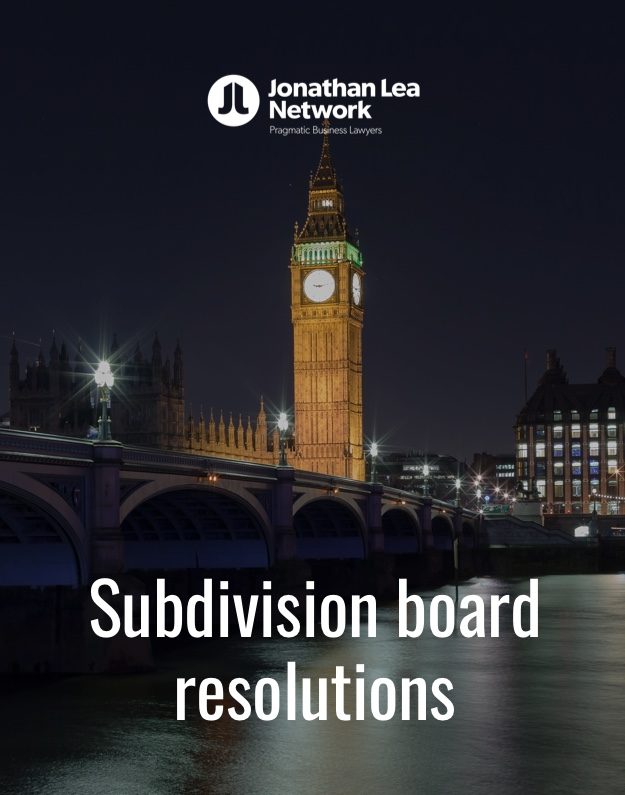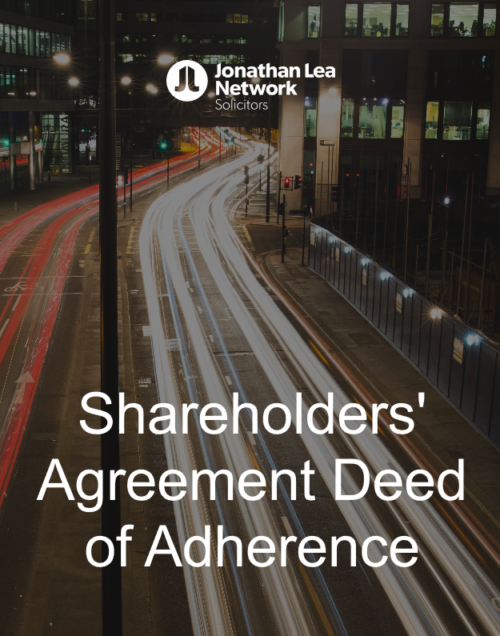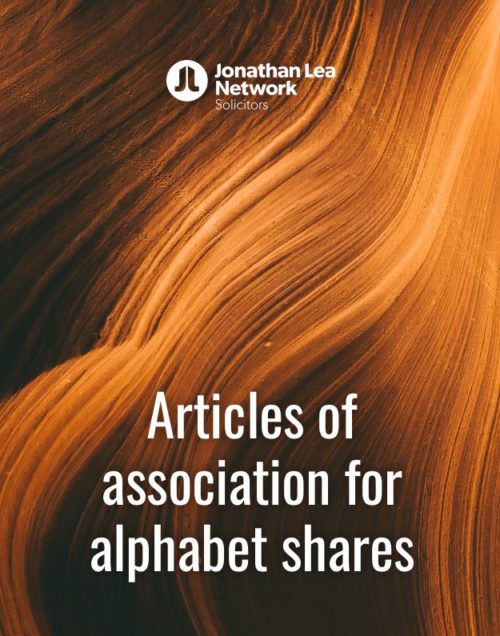Subdivision board resolutions
£6.99
These guidance notes have been put together by our in-house team in order to assist you with filling out the written board resolution template which records a company’s board of directors agreeing to subdivide the company’s share capital.
We have kept the template as simple as possible and it will therefore not be relevant to every scenario. The template will need to be adapted depending on the company and the circumstances of each case and further detail will need to be added for example if the company has a shareholders agreement in place which contains restrictions on subdivision, or if the company’s articles of association contain restrictions on the company’s ability to subdivide its share capital.
The only drafting that needs to be done from your side is to insert the relevant information into the square brackets. The wording inside the square brackets which we have included explains clearly the information that should be inserted. You are advised to fill in the wording in square brackets in lower case. Any figures should be entered in numerical form. The brackets should be removed after the amendments are made (so as to produce a ‘final form’ version of the written board resolutions).
What is the difference between board and shareholder resolutions?
The board of directors of a company manage the business of the company on a day-to-day basis. The directors have authority to make decisions on behalf of the company, except those that the Companies Act 2006 (“Act”) or the articles of association of the company (or any shareholders agreement the company has in place) require the shareholders to make. The point of a board resolution is to address a specific issue that the board needs to decide on (here, to approve the company subdividing its share capital and to instruct the shareholders of the company to pass an ordinary resolution to authorise the subdivision). Board resolutions therefore reflect decisions made by the board of directors of a company.
Shareholder resolutions can either be made by way of an ordinary resolution or a special resolution. The distinction between ordinary and special resolutions is set out in detail below. Some decisions of the company must be made by way of a resolution of the shareholders, for example the company can only amend its articles by passing a special resolution of the shareholders and a company can authorise its directors to allot (i.e. issue) new shares by the company’s shareholders passing an ordinary resolution. Shareholder resolutions therefore reflect decisions made by the shareholders of a company.
Company name and number
The first two brackets within the form relate to the company name and number. The company number should be entered in numerical form, and the name of the company should be typed out in capital letters.
The company number is its registration number and can be found by searching the company’s name at Companies House.
Paragraph breakdown
Paragraph 1.1
This paragraph states clearly the number and class of shares that the company had in issue prior to the subdivision (i.e. the company may initially have had 100 ordinary shares of nominal value £1.00 each in issue). It also shows the number and class of shares that the company will have in issue following the subdivision (i.e. the company could subdivide its share capital so that its 100 ordinary shares of nominal value £1.00 each instead become 1,000 ordinary shares of nominal value £0.10 each).
The first bracket to be filled out under this paragraph is the number of shares the company currently has in issue (prior to the proposed subdivision), and should be entered in numerical form. In the second bracket which immediately follows the first, you should insert the class of the shares, for example ‘ordinary’ or ‘A ordinary’ (the company may have ‘A ordinary’ and / or ‘B ordinary’ shares in issue if it has implemented an alphabet share structure, with the holders of each type of share having different rights).
The third bracket under this clause requires the nominal value of the company’s issued shares prior to the subdivision to be entered. This should be typed numerically, and the sign for pound sterling can be changed accordingly.
The fourth bracket under this clause requires you to insert the total number of issued shares that the company will have in issue following the subdivision, and should be written numerically. The fifth bracket requires the class of these shares to be entered.
The sixth bracket under this clause requires the new nominal value of the company’s issued shares following the subdivision to be inserted – this should be typed numerically, and the sign for pound sterling can be changed accordingly.
By way of example, paragraph 1.1 would read as follows were the company in question to subdivide its share capital of 100 ordinary shares of nominal value £1.00 each so that its share capital becomes comprised of 1,000 ordinary shares of nominal value £0.10 each:
“1.1 THAT the directors of the Company wish to consider and, if deemed fit, approve various matters in relation to the proposed subdivision of the Company’s current issued share capital of 100 ordinary shares of nominal value £1.00 each so that the issued share capital instead becomes 1,000 ordinary shares of nominal value £0.10 each held in the same proportions by the existing shareholders; and following such subdivision”.
Paragraph 1.2
This paragraph refers to the relevant section of the Act which provides that a company is permitted to consolidate or subdivide its share capital by a resolution of the members. As section 618(3) of the Act does not specify the type of resolution required (i.e. whether ordinary or special), the default position under the Act (in accordance with section 281(3) of the Act) is that an ordinary resolution will be sufficient unless the company’s articles require a higher majority or unanimity (or indeed if the provisions of the company’s shareholders agreement requires a higher majority or unanimity – though this is not stated in the Act).
An ordinary resolution will pass if shareholders holding more than 50% of the company’s shares vote in favour of it. Therefore (using the example given above), if the company has two shareholders who own 50 ordinary shares each (i.e. 50% of the company’s shares), they will both have to vote in favour of the ordinary resolution in order for it to pass. Note that shareholders holding more than 50% of the company’s shares must vote in favour of the resolution – shareholders holding 50% of the company’s shares exactly will not be sufficient.
Paragraph 1.3
The wording in this paragraph effectively reiterates and confirms the wording already contained within paragraph 1.1, but has been included for the avoidance of doubt. The words and figures to be inserted in the square brackets in this paragraph are the same as what you will have inserted under paragraph 1.1.
Again, using the example above, the wording in this paragraph would read as follows:
“1.3 THAT, subject to the passing of the Subdivision Resolution, the Company’s share capital be subdivided to create 1,000 ordinary shares of nominal value £0.10 each”.
Board resolutions
The board resolutions do not require any amendment and can be left as drafted.
The board resolution at paragraph 1 confirms that the board will approve the subdivision of the company’s share capital and that the ordinary resolution required to approve the subdivision (referred to as the ‘Subdivision Resolution’) will be passed (i.e. ‘executed’) accordingly.
The board resolution at paragraph 2 shows the directors of the company complying with their director duties under the Act and confirming that the proposed subdivision will promote the success of the company for the benefit of its members as a whole.
The board resolution at paragraph 3 confirms that the company will file an SH02 form at Companies House in order to notify them of the subdivision (as is required under the Act). The SH02 simply reflects the subdivision and confirms the new share capital of the company. The Act provides that the SH02 statement of capital form must be filed at Companies House within one month of the subdivision taking place (in accordance with section 619(1) of the Act).
Note that as an ordinary resolution is usually required in order to effect a subdivision of a company’s share capital, it will not need to be filed at Companies House (as ordinary resolutions only need to be filed at Companies House in exceptional circumstances). If the company’s articles of association or provisions in its shareholders agreement (if it has such a document in place) provide for a special resolution to be passed (special resolutions require shareholders holding not less than 75% of the company’s shares to vote in favour of it in order for it to pass) in order for the company to subdivide its share capital, then a copy of the special resolution will need to be filed at Companies House (as the Act requires copies of special resolutions to be filed at Companies House within 15 days of their being made).
Note further that all directors of the company should sign the written board resolutions and so additional signatory spaces will need to be inserted should the company have more than one director.









